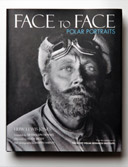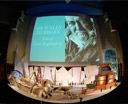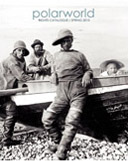 Our ProductsOur Resources |
This website requires the free Flash plugin to be installed.
Polarworld - discover more polar booksThe Arctic Book Review Science and the Canadian Arctic: Science and the Canadian Arctic: A Century of Exploration, 1818-1918 Trevor H. Levere Reviewed by Jonathan Dore CUP has now printed a paperback edition of Trevor Levere's encyclopedic survey of the first century of science in Canada's high Arctic, first published in 1993. Although the history of science is a burgeoning area of study and publication, there have, I suspect, been few developments to disturb the author's judgements or conclusions in the intervening eleven years, which is probably why no changes to the text, new footnotes, or even a new preface seem to have been considered necessary. This might be an indication that few people are working in the area, but I suspect it is also an eloquent testimony to the book's definitiveness. Levere, a professor at the University of Toronto, is best known for his work on the 18th and 19th century history of chemistry, but here he is on the other main track of his studies: science in Canada. Science in Canada, but until the latter part of the story, not science by Canadians. Levere's chosen period, starting with John Ross's first British naval expedition and ending with Vilhjalmur Stefansson's third expedition, is almost exactly bisected by Confederation, Canada's beginning as an independent nation in 1867. It took a while for the effects of the new national presence to be felt: Britain did not transfer to Canada title to the Arctic archipelago until 1880, and the very last expedition in the book, Stefansson's, was the first to the Arctic to have official Canadian government backing. For most of the 19th century, the Canadian north had been, in geopolitical terms, a blank arena in which the competing nationalisms of Britain, Russia, the United States, and Norway had played out their complex dance around each other, here challenging, there cooperating with each other as the priorities of prestige and powe, decided elsewhere, were played out. The tension between "pure" science and "mere" geographical exploration, and the constant subordination of scientific aims to political ones, are themes that run throughout Levere's superbly detailed study, which, like some of the polymathic practitioners he writes about, seems equally at ease in all scientific disciplines. Like an exploration history, Levere's book is a roughly chronological account in which the basic unit is the expedition, but from a very different perspective than one is used to reading. Ships' surgeons, and midshipmen with a bent for natural history or sketching, rather than expedition commanders, come to the fore. From this viewpoint, the most significant individual from the the first thirty years of the period covered is not Franklin or Parry, but John Richardson. The surgeon and Franklin's second-in-command on the latter's first two expeditions, he emerges as a renaissance man of extraordinary versatility, able to make important contributions to the geology and botany of the Arctic, but (not surprisingly, given his medical training) doing his most important work in zoology: sketching, collecting, preserving, and classifying many birds, mammals, and insects new to science, both in the field and working at home on specimens collected by others. While he came before the general public as the author of urbane and engaging supplements to Franklin's published expedition journals, Richardson's real monument is his Fauna Boreali-Americana (1829-37), a 1,500-page, 4-volume synthesis of all the knowledge of animal life in the Canadian Arctic that he and others had collected to that time. Richardson took a judicious middle path between two camps in the zoology of his day: the splitters tended to look for differences between specimens, proposing the slightest divergence as evidence that they were different species (the right to name a new species may also have been a source of temptation). Ranged against them were the lumpers, who lumped diverse specimens together, assuming that differences between them were merely individual. The divide highlighted the limits of doing classification by examining dead specimens in a lab. Without a significant, living population to study, zoologists could only guess how representative their samples were, and without time or opportunity to observe behaviour in the wild, they could not tell if populations were interbreeding, and thus still part of the same species. A further limit was theoretical: before Darwin published the Origin of Species in 1859, there were no clear principles for understanding how speciation was driven by the separation of populations through geological and climatic forces, and their subsequent adaptation to different environments. Richardson was a navy man, and the Royal Navy was the main vehicle through which science was carried out in the Canadian Arctic in the first half of the book's coverage. Ironically, it was an institution that was constantly suspicious of scientists and did much to frustrate their work. Levere points out that this mutual antagonism dates back to 1698, when Edmond Halley was given command of the Paramore on an expedition to the South Atlantic to measure terrestrial magnetism. Friction between Halley and the officers assigned to him was so bad that the admiralty vowed never again to put a scientist in command. This ensured that science could only ever take place within the overall priorities of an expedition whose main goal was usually geographical discovery, the mundane filling in of blank spaces on the map that scientists tended to regard with impatience. This policy also meant that very few professional scientists (as we now regard them) ever went to the Arctic on British expeditions, even in subordinate positions. Instead, the navy insisted that they train officers to make the observations for them (just as NASA trained its test-pilot astronauts to become stand-in lunar geologists until a real geologist finally got to the moon in 1972). This does not seem to have been the case elsewhere: Cook found room on his ships for Joseph Banks and Reinhold Forster in the Pacific, after all, as did James Clark Ross for Joseph Hooker in the Antarctic. Why the Arctic should have been regarded differently, and so stingily, makes one interesting question that Levere sadly doesn't choose to address. As it was, the quality of whatever good results emerged from the navy's practice in the Arctic was only due to the fact that a steady supply of intelligent, eager, well-educated officers like Richardson (or the 1875-76 British Arctic Expedition's Henry Feilden) were willing to carry out the various tasks so diligently. Scientific interest in the Canadian north did however coincide with the navy's practical concern for navigation in one area: geomagnetism. Here the region played a crucial role, as it became clear that the North magnetic pole was located in the Canadian Arctic, and scientists began to piece together the connection between it and the aurora borealis. Through most of the century, geomagnetism and its equipment (compasses, dip circles, unifilar magnetometers) are a constant refrain in Levere's narrative, while the punishing schedules of observation they required tested the souls of even the most ardent martyrs for science. Every hour round the clock, on every day for months or even (for the unluckier expeditions) years at a time, the instrument's readings had to be taken. Then on term days (prearranged dates on which readings were to be taken by observatories around the world, allowing a truly global picture to be built up) the pace stepped up to 5-minute intervals, finishing with a final-hour sprint of readings every 20 seconds. No wonder each expedition returned with reams of raw data, and why the task of reducing and publishing it sometimes took years. Publication was one of the ways in which science was increasingly internationalized through the century; for instance, the scientific results of McClintock's Fox expedition (1857-59) were published by the Smithsonian Institution. Geomagnetism was, perhaps predictably, the science that motivated the first concerted move towards internationalism in science, the International Polar Year (IPY) of 1882-83, which saw 12 countries send parties into the field for a period of intensive observations with coordinated term days. Canada still "had no focus for lobbying government on behalf of science," so in the event a British expedition of uncharacteristic smallness and efficiency was sent, by the army rather than the navy. With a singular focus on magnetic studies and without the input from a wide range of disciplines that characterized most other expeditions that year, the Woolwich Arsenal's published results made one of the slimmest volumes of any of the participating countries, a testament to Britain's Arctic fatigue. The Smithsonian's publication of McClintock's results was not an isolated occurrence. The institution's secretary, Joseph Henry, and under-secretary, Spencer Baird, became assiduous patrons of plant and animal collectors (mostly Hudson's Bay Company traders filling their spare time). Where their British counterparts had been used to getting the first pick of specimens without having to ask, Henry and Baird unsurprisingly found that politely framed requests, accompanied by needed supplies, books, and the occasional disguised bottle of whisky, put the Bay men in a much more congenial frame of mind. Thus the Smithsonian charmed its way into building up the continent's finest collection of Arctic natural history specimens, while the director of the Edinburgh museum who failed to even acknowledge receipt of HBC trader Bernard Ross's shipment of preserved bird must have wondered, vaguely, why he never received any more. The Smithsonian's involvement in Arctic science symbolized growing American activity more generally. Kane, Hayes, and Hall had all made the standard magnetic observations, Franz Boas had made the first ethnographic studies of the Inuit on a properly scientific basis, and Greely's U.S. Army expedition put in a heroic contribution to the IPY, though at a famously tragic cost. But generally, Arctic science was steadily becoming more internationalized as scientists became less dependent on government and the military to get into the Arctic, and the fundamentally cooperative, border-blind nature of the activity shone through. This did not mean that conflict was over, however: competition between the sciences could be fierce. Rudolph Anderson, an instructor at a U.S. Army academy with a passion for zoology, accompanied Stefansson on an expedition in the Yukon and Alaska in 1908-12, and ruefully noted in a letter to his wife at home: I suppose nobody ever got out a scientific report that pleased everybody. The ornithologists and mammalogists will wonder why I did not get more specimens, the bug men will surely be sore, for I have caught only a few vials full of insects, the botanists will expect hay-bales of plants, and the geologists think that our boats and sleds should be ballasted with rocks at all times. But what is a man to do! The oldest and most fundamental national motivation of all, however, control of territory, unexpectedly raised its head again in the Canadian Arctic. Otto Sverdrup's great expedition of 1898-1902 (the first to survive four winters in the Arctic since John Ross in 1829-33) added four major new islands to the map, raising the spectre of a possible Norwegian claim to territory in the western hemisphere. Canada eventually solved that problem by a direct cash payment to Sverdrup in 1928, but its first response was to launch, after some prodding, its own expedition to sweep up any remaining undiscovered land in the archipelago and claim it for Canada. It was entrusted to Vilhjalmur Stefansson, who over five years (1913-18) found four further islands and made the sensational discovery of what he called the blond eskimos, but managed, infamously, to lose his ship, the Karluk, and all who were in her. Away from the tragedy and the grandstanding, however, the real scientific work was carried out by a party led by Anderson, surveying coastline, taking depth readings, and collecting animals and plants that belatedly gave Canada a collection of its own natural history specimens comparable to that collected in the previous century by other countries. The two faces of the expedition summed up the never-ending tension between science and the political context in which it operates, and set the scene for another century in which the scientist's work would be grist to the politician's mill. |
|
||
follow us  | join us | join us  | home | contact | home | contact
|
||||
|
© Copyright Polarworld Ltd
SiteWizard.co.uk Web Site Design Company |
||||


